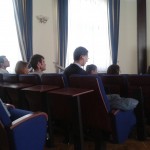„Alexandru Ioan Cuza” University of Iași,
Faculty of History,
Centre for the History of International Relations
Organise
The International Conference
The diplomats’ society in the Romanian public space. Perceptions, images and representations in the last decades of the 19th century and the first half of the 20th century
„Alexandru Ioan Cuza” University of Iași, 30–31 October 2015
history.uaic.ro/research/foreigndiplomats
The event will take place on the 30th and the 31st of October 2015 at the “Alexandru Ioan Cuza” University of Iași, Romania. The conference is organised within the framework of the project Foreign diplomats in the Kingdom of Romania. Ways of socialisation and mundanity experiences (1881–1914), supported by the Romanian National Council of Scientific Research CNCS-UEFISCDI, project code PNII-RU-TE-2012-3-0288.
Update 20 October 2015: The Book of Abstracts is available for download.
Update 20 October 2015: The final programme of the conference is available for download.
CfP May 2015: First Call for Papers.
Argument
The last decades of the 19th century seem to be a period in which diplomacy acquired, apart from increased professionalism and moderate bureaucratic skill, a definite autonomy of expression in relation to the state. This is the interval in which diplomats exercise a certain influence on society and start adding value to their actions, sometimes above and beyond the directions given by foreign ministers. Diplomats act according to shared norms, recognize themselves as an epistemological community and form a society based on principles and values. The diplomats’ society must not be mistaken for the extension of protocol rules and customs at European and world level. It involves a kind of uniformisation that underpins, beyond the war, in the emergence of the new diplomacy, due to a shared feeling of belonging that generates behaviours and attitudes stemming from observation rather than from education or training. The diplomatic corps is the legal entity expressing itself according to pre-established rules, while the diplomats’ society is the sum of knowledge defining human, rather than professional, interaction.
The 19th century is often viewed as the golden age of the career diplomat. Diplomats are selected from among the most competent, wealthy and sociable people of a country. They have a shared heritage and foster a community spirit that is specific to the European gentleman. They go to elite schools and share a common vision of the world they live in. On the backdrop of the rapid technological, military and economic development of Europe, diplomats are increasingly more inclined to recognize their commonalities. Before the First World War, despite the bureaucratisation of the state functions, diplomacy remains in many countries a bastion of nepotism and favouritism, the realm of aristocrats and noblemen. Aristocratic prestige is part of an old tradition that associates, at the scale of the pre-war society, the diplomatic corps with the community of experts in decrypting and running international relations. Between the two World Wars, the old tradition survives only sporadically, diplomacy is intensely bureaucratized, and thus the new community is perceived, more often than not, in administrative terms. The diplomats’ society, however, remains unchanged. The natural thirst for information amplifies the effort in perceiving and representing this world. Before becoming genuinely transparent, diplomacy aroused the curiosity of people from various social layers through its acts. In the public space, the aim was to obtain better knowledge of social behaviours, to oversee mores, to humanize the profession. However, the phenomenon is ambivalent, although for different reasons. The diplomats themselves construct images of the world they live in, as their professional obligations force them to portray the environment in which they work. The conference aims to reconstruct this type of ambivalent perception, to rebuild the images formed in time and to explain their spread. The public space is the stage of unpredictable and unconventional representations, the meeting point of images developed through the perception of characters of different rank. The diplomats’ society thus appears as an object of observation, interrogation and judgement for the local subjects. The representations that cross paths in the public space can be reconstructed by making a conscious effort to recover and analyse in retrospective certain categories of sources, intensely used in diplomatic history, in order to outline the path taken by the talks and discussions rather than to show the imagological side: letters, memoirs, press, diaries etc.
The conference will be organised in three separate sections:
- Romanian society in the representations of foreign diplomats (professional structures; social hierarchies; endemic conflicts; mores, spiritual values, psychological inclinations; states of mind, etc.)
- Local judgement. Foreign diplomats in the Romanian public space (physical appearance; moral portraits; education and skills; mental state; soirees, receptions, trips to the countryside; press scandals etc.).
- Genesis of representations and the vehicle of imagery. Press, memoirs and letters (deconstruction of discourse; sequence of presentations; sources and accuracy of information; style; language; objectivity versus subjectivity; historical relevance etc.)
Photo Gallery







